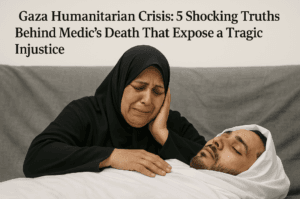Gaza Humanitarian Crisis: 5 Shocking Truths Behind Medic’s Death That Expose a Tragic Injustice
Rifaat Radwan, a 23-year-old Palestinian medic, was killed alongside 14 colleagues in Gaza by Israeli forces on March 23 while responding to distress calls in a marked ambulance convoy. His mother, Umm Mohammed, recounts the devastation of burying her son—her family’s sole provider—days before Eid al-Fitr, a holiday now shadowed by grief.
Video evidence from Rifaat’s phone, filmed moments before his death, disproved Israel’s initial claims that the ambulances lacked lights and posed a threat, revealing instead a barrage of gunfire targeting clearly visible medics. Survivor Munther Abed describes hiding as colleagues gasped their final breaths, later enduring detention and beatings by troops who buried the bodies in shallow graves.
The Palestinian Red Crescent Society condemns the attack as a deliberate war crime, citing forensic reports of fatal shots to vital areas, while Israel’s military—revising its narrative—suggests vague “threats” without evidence. Rifaat’s story underscores the peril faced by Gaza’s humanitarian workers, over 50,000 dead in the conflict, and a systemic failure to protect those bearing medical emblems. As families plead for accountability, his mother’s anguish echoes a universal truth: in war, the bravest often die not as soldiers, but as healers caught in the crossfire.

Gaza Humanitarian Crisis: 5 Shocking Truths Behind Medic’s Death That Expose a Tragic Injustice
In the days leading up to Eid al-Fitr, a time traditionally marked by feasts, family reunions, and laughter, Umm Mohammed prepared for a ritual no parent should endure. Instead of adorning her home with lanterns or wrapping sweets for her son Rifaat, she waited in a tent in central Gaza for his body to be unearthed from a shallow grave. Rifaat Radwan, a 23-year-old Palestinian medic, was one of 15 emergency workers killed by Israeli forces on March 23 while responding to calls for help in southern Gaza. His story—captured in haunting video footage and a mother’s unyielding grief—exposes the perilous reality faced by humanitarian workers in conflict zones and the human cost of systemic impunity.
A Son’s Final Moments: Courage Amid Carnage
Rifaat’s last act was quintessentially him: filming his ambulance’s journey through the dark outskirts of Rafah, headlights piercing the night, as he reassured his mother in a voice message. “Forgive me, mother… this is the path I chose to help people,” he said, his voice steady amid the roar of gunfire. The footage, recovered from his phone after Israeli troops buried his body in sand, contradicted initial military claims that the convoy approached “suspiciously” without lights. Instead, it revealed a chilling truth—medics in marked vehicles, illuminated and vulnerable, were met with over 100 rounds of gunfire.
For Umm Mohammed, the video confirmed her worst fears. “My heart and soul died when Rifaat was killed,” she says, her voice breaking. “He was my支柱 [pillar].” Rifaat, the family’s sole provider, had volunteered with the Palestinian Red Crescent Society (PRCS) after Israel’s military campaign began in October. He transported the wounded across bombarded roads, even escorting patients to Egypt’s Rafah crossing. “He knew the risks,” his mother admits, “but he believed in saving lives, not taking them.”
Survivors’ Stories: Trauma and Accountability
Munther Abed, a paramedic who survived the attack, recounts diving to the ambulance floor as bullets tore through the convoy. “I heard only gasps—the sound of my friends dying,” he says. Detained and beaten by Israeli forces for 15 hours, Munther later learned his colleagues—his “second family”—had been buried hastily, their bodies decomposing for a week before recovery. The PRCS, which lost 27 workers since October, condemns the incident as a “war crime,” citing forensic reports showing targeted shots to the head and chest.
Israel’s military, after revising its initial account, now claims troops perceived the medics as threats due to a prior encounter and alleges six were Hamas operatives—a claim the PRCS vehemently denies, demanding independent evidence. While the IDF pledges a “thorough examination,” critics argue internal inquiries lack credibility. “Without accountability, these crimes will repeat,” says PRCS spokeswoman Nebal Farsakh.
Eid Without Joy: A Symbol of Collective Loss
For Umm Mohammed, Eid’s arrival days after retrieving Rifaat’s body underscored Gaza’s collective trauma. “We buried him in silence,” she says. “No laughter, no new clothes—just a gap where he should have been.” Her anguish mirrors broader despair: over 50,750 Gazans killed, 1,200 Israelis dead in Hamas’ October attack, and 59 hostages still missing. Yet behind these numbers lie stories like Rifaat’s—of ordinary courage, fractured families, and a world where humanitarian emblems offer no protection.
The Unanswered Questions
This incident raises urgent questions about compliance with international law, which mandates protection for medical personnel. Why were clearly marked ambulances fired upon? Why were bodies concealed, and why has evidence been delayed? For Munther and Umm Mohammed, answers matter less than justice. “Rifaat’s killers must be named,” his mother insists. “Or his death—and ours—means nothing.”
As global attention wavers, their voices underscore a stark truth: in conflicts where power imbalances prevail, the burden of proof too often falls on the victims. Until independent investigations replace unilateral claims, Gaza’s medics—and the families left behind—will remain casualties of a war beyond their making.
Final Insight
Rifaat’s story is not an anomaly but a testament to the normalization of violence against humanitarian workers in Gaza. His mother’s grief, paired with Munther’s survivor guilt, humanizes a crisis often reduced to statistics. Their calls for accountability challenge the international community to confront uncomfortable truths: when symbols of healing become targets, humanity itself is under siege.
You must be logged in to post a comment.